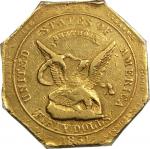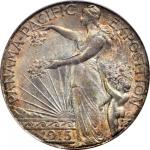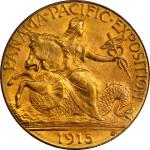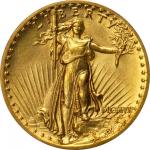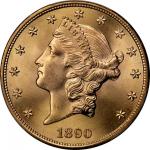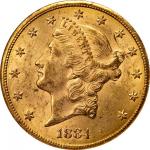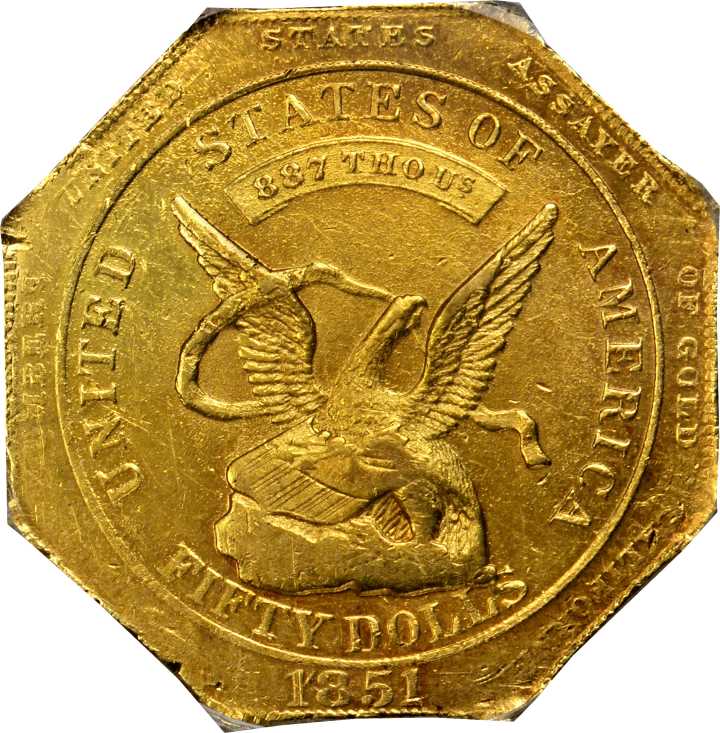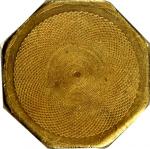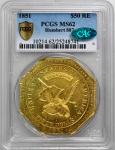This is an extraordinary coin in all regards that ranks among the finest Humbert fifty-dollar gold pieces extant of any issue or variety. The amount of detail evident on both sides is far and away superior to that typically seen in survivors of this type. The incredible Mint State level of preservation certainly plays an important role in this -- most survivors are well worn -- but not to be overlooked is an above average quality of strike. All features are sharply impressed and crisply detailed apart from a touch of characteristic softness to the high points of the eagle and in isolated areas around the peripheries on both sides. The surfaces are aglow with bright, satiny, khaki-gold luster that further enhances already memorable eye appeal. Overall smooth, and rarely so in an example of this often well worn and/or heavily abraded type, there is much to recommend this coin to the advanced Territorial gold specialist. Indeed, we expect that this piece will have little difficulty finding its way into either one of the finest Territorial gold coin cabinets or a more expansive collection focusing on California Gold Rush history. In either it is destined to serve as a highlight, if not the centerpiece.James Wilson Marshall s discovery of gold in California s American River on January 24, 1848 kicked off one of the largest, and certainly the most romanticized gold rush in United States history. As news of this discovery spread, 300,000 people from both the Eastern United States and abroad would eventually make their way to California seeking wealth and prosperity. Some did strike it rich, although the majority bettered themselves little, either financially or otherwise. The Gold Rush and the large influx of people that it brought to California (the first great surge of which came in 1849, hence the popular cultural term "Forty-Niners") resulted in immense changes across the fabric of American life, both in California and throughout the burgeoning nation. For example, the close proximity of San Francisco to the gold fields made it an attractive port of entry for those arriving in California by sea, and also as an outfitting center and base of operations for gold seekers. A small settlement of 200 souls in 1846, San Francisco had grown exponentially into a city of 36,000 people by 1852. With great change and, ultimately, great progress, came trials and setbacks. In the economic sphere, the area of focus for numismatists and others interested in the coinage of the era, such a tremendous surge in population in a short period of time resulted in an acute shortage of circulating currency. After all, there was no established mint in the area when the Gold Rush began, and what little coinage the "Forty-Niners" and others brought with them was woefully inadequate to sustain an economy, either immediately or over time. Gold dust, which was quickly adopted as a medium of exchange, proved difficult to work with in this regard and little more than a stopgap measure. Then there was the additional problem of what to do with all of the gold that was being mined. Clearly it needed to be converted into a form that was universally acceptable so that it could not only be used in commerce in California, but could also be transported to New York, Philadelphia and other major economic centers so as to contribute to the nation s larger economy. As early as 1849 proposals were introduced both in the California Legislature and United States Congress calling for the establishment of an assay office or branch mint in California. Competing political interests delayed action on the federal government s part, and most Californians wanted more than simply a state-run assay office. The ability of a federal branch mint to not only convert newly mined gold into large coins and ingots but also to strike much needed smaller denomination coins was deemed far more appropriate given the local economic situation. To meet the immediate economic needs of Gold Rush California while final action on the part of the state and/or federal government was awaited, various private minting firms sprang up in and around San Francisco. Some were short-lived and produced few coins and/or ingots, often of poor quality, and sometimes of inadequate weight and/or fineness so as to be deemed unacceptable in commerce. The firm of Moffat & Co., however, became the most important private minter serving the California Gold Rush, its successors Curtis, Perry and Ward eventually selling their coinage facility to the United States government, which reopened it as the San Francisco Mint in March 1854. While still under the auspices of Moffat & Co., the firm s reputation caught the eye of the federal government when the latter was finally able to take action in the establishment of a local coinage facility to service the Gold Rush. Unfortunately, however, Californians did not initially get the branch mint they desired, for competing political interests made it impossible for senators Thomas Hart Benson and William M. Gwin -- champions of this cause in the Thirty-first Congress -- to get this proposal approved. Rather, a compromise bill passed through Congress on September 30, 1850 and established the United States Assay Office, to be located in San Francisco. Moffat & Co. received the contract to operate as the United States Assay Office, with New York watchmaker Augustus Humbert appointed as United States Assayer. Humbert arrived in San Francisco on January 30, 1851, bringing with him the first dies for coinage that had been prepared by Charles C. Wright. The first coins -- $50 gold pieces -- were issued under Humbert s authority the following day, with ingots following on February 14. The United States Assay Office continued to operate with these principals until the dissolution of Moffat & Co. in early 1852, after which the federal contract was assumed by Curtis, Perry & Ward under the name of the United States Assay Office of Gold. Humbert remained as assayer under the successor firm until it ceased operations on December 14, 1853 in preparation for the opening of the San Francisco Mint. Nearly a branch mint in its own right, the operations of the United States Assay Office in 1851 and 1852 represent an important and defining chapter in the coinage history of the California Gold Rush and, indeed, the nation as a whole. One of Humbert s $50 gold pieces from his first year as assayer in California, this rare and beautiful Mint State coin offers the advanced collector with an important opportunity to own one of the most impressive mementos of this widely studied and avidly collected era in United States frontier history., Est. $200,000-$300,000

